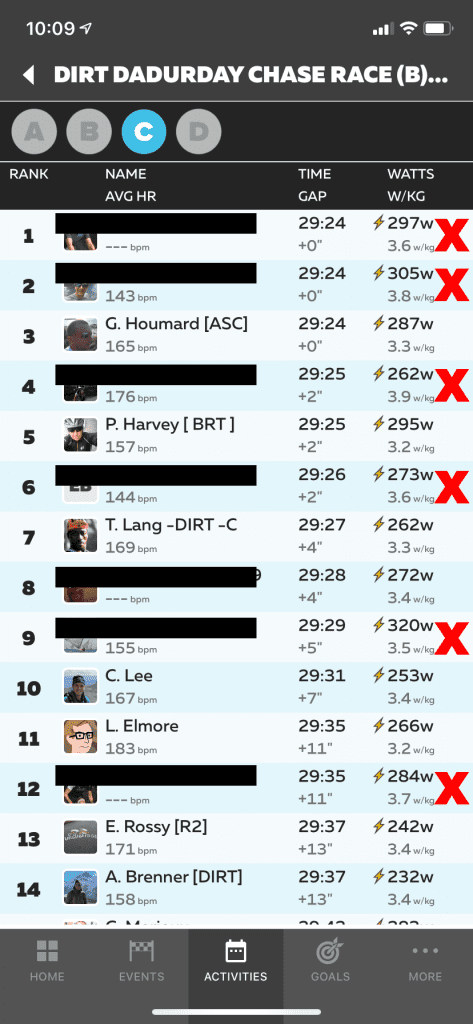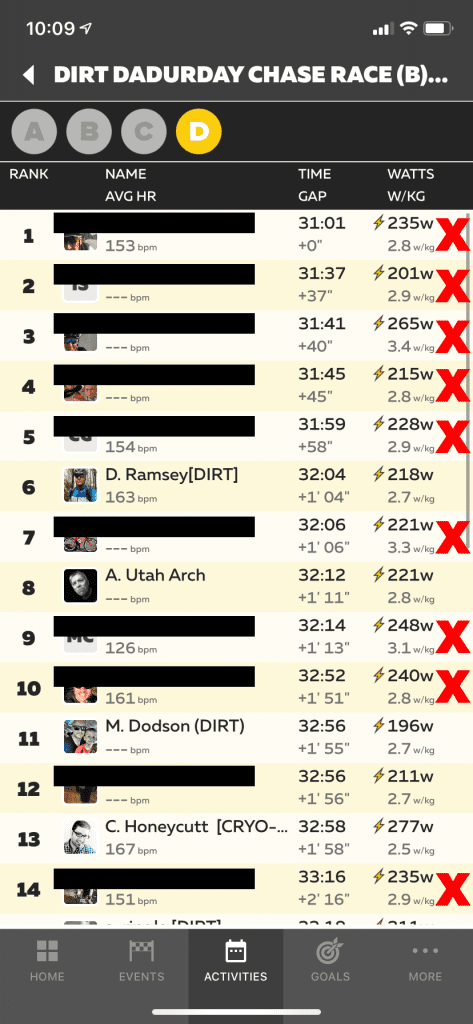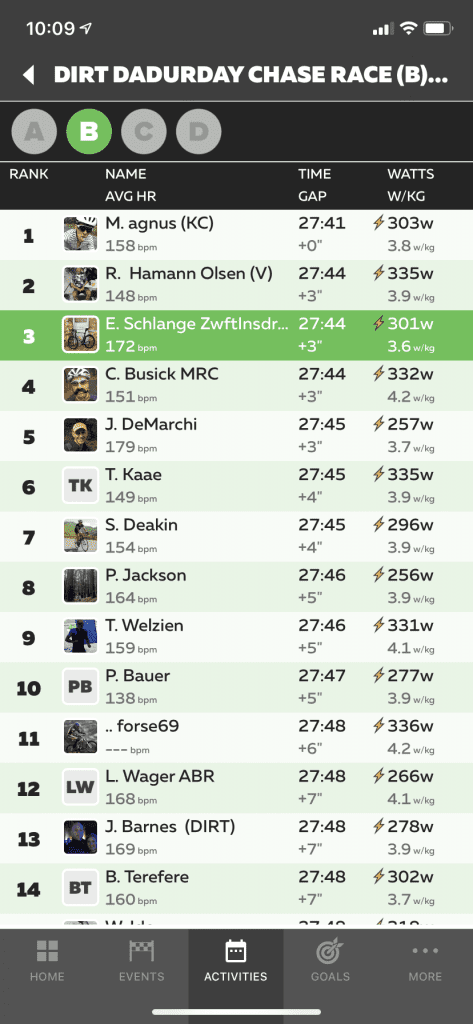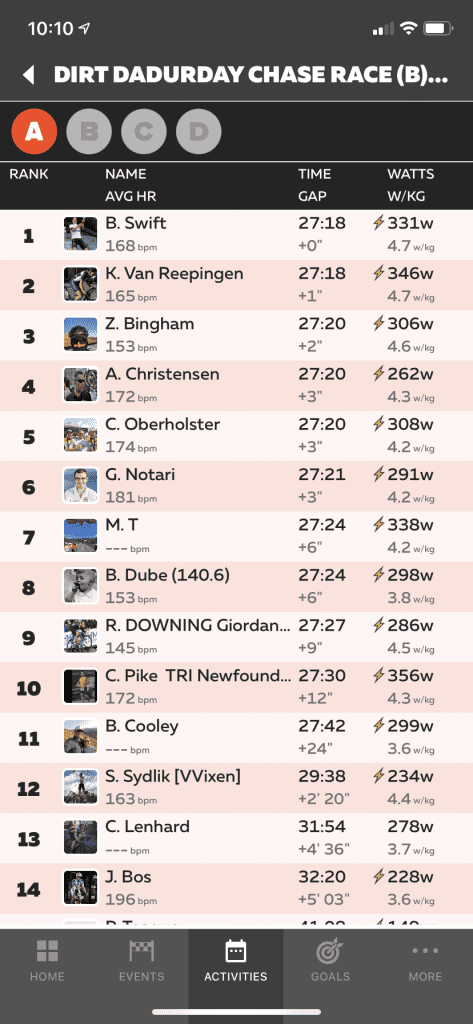With 284 Zwift races under my belt, you could say I’m pretty experienced. What has all that experience taught me? Quite a bit, really. Mostly the same things over and over again. I’m not a climber. I’ve got a decent sprint, but can’t attack and stay away to save my life. I can dig deeper than my mind says.
But today I want to talk about one race that stands out as a wholly unique experience against the background of my other 283 races: the DADurday Chase Race of November 23, 2019.
DADurday: an Introduction
The DIRT DADurday Chase Race is one of Zwift’s most popular weekly handicap races. (Not sure what a “handicap race” is? Read the beginning of this post.) Held on Saturdays in two different time slots, these events have become legendary for pushing riders to their limit as they work with their category for most of the race, then go all-in for the finish.
See upcoming DADurday Chase Races >
Warming Up
It was Saturday, which is my long ride day, so my goal was to get a hard race effort in, followed by some additional miles on tired legs to really push the fatigue.
So I began with my typical pre-race ritual: a piece of caffeine gum and some PR lotion on the legs. Hopped on early and put in ~8 miles to warm up, then headed over to NYC for the 6:45am DADurday. Seven laps of NYC’s LaGuardia Loop–this was going to be a short race!
I checked the rider list in Zwift Companion before the race began, and noticed one name I recognized in the A group: Ben Swift. British National Road Race champion. Team Ineos rider. Yes, that Ben Swift.
We were going to have our work cut out for us in the B’s…
The Undeserving Beacon
Months ago I’d been asked by DIRT organizers if I could be a leader for the DADurday B’s on the weeks I showed up. I said yes–and promptly neglected to show up. (The problem is, I really enjoy the P Race, which begins 15 minutes after DADurday…)
I’m still on the leader list even though I’ve only raced a few DADurdays–so when I popped into the start pin, there was the leader beacon above my head. It screamed “Follow me, I’ll lead you to glory!” when in fact I had no idea if I’d even be able to hang with the front group, let alone wisely direct the group on its optimal pacing.
Oh well–it is what it is! Let’s race.
The Start
Early in every chase race, someone always asks, “What’s our target pace?”
I never know how to answer. Our goal is simple: to catch the C’s and D’s ahead of us, and stay away from the A’s behind. But the pace? I have no idea what pace is required in order to achieve that goal. Nobody does!
So I usually say something like, “4 w/kg+ if you’re on the front. Then sit in the pack to recover.” But really what that means is, go as hard as you can. Get on the front and hammer to pull the group along, then recover in the draft a bit, then hammer again. And if you really want to be a team player, use your aero powerup off the front to pull the group extra fast!
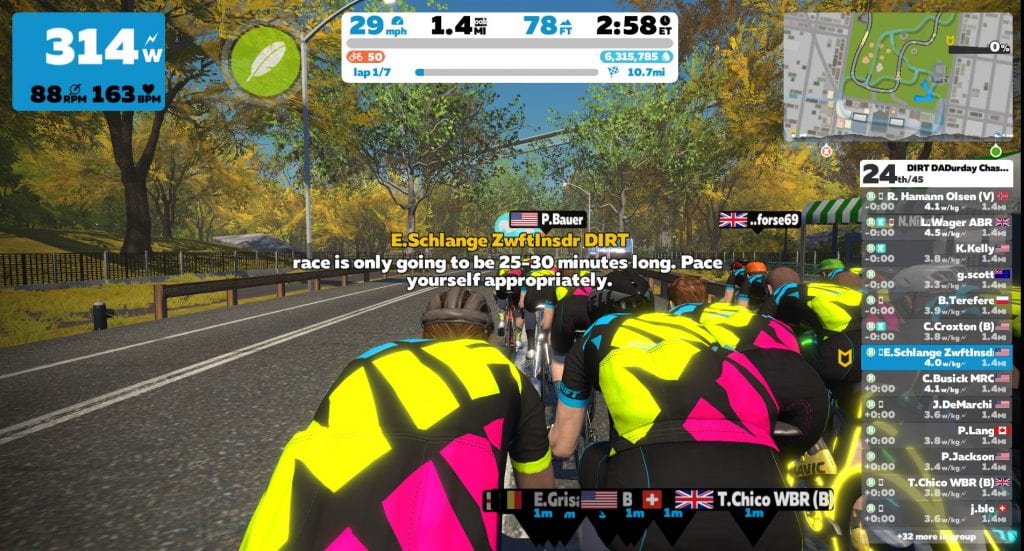
Unlike a typical Zwift race, chase races start more gently, since everyone knows the group has to stay together to stand a chance at winning. So that’s how we started–a tame but solid ramp up to race speed (~28mph), where we would sit for the rest of the event.
The Middle
Here’s the tricky thing about chase races: it’s hard to keep tabs on the other groups from within Zwift. I already talked about pacing a bit above, but here’s my more detailed pacing strategy for chase races: give only what is required to catch the riders ahead, while staying away from the chasers. Because you’ll need everything you’ve got left for the final sprint if you make it to the front pack.
With this strategy in mind, it becomes obvious that knowing the positions of the other categories is really helpful. But the only way to do that reliably is by having ZwiftPower’s Live event results up on another screen–and I hadn’t done that.
I told you I was a bad beacon!
So this is where things got messy. On a long route it’s easier to spot groups on the map and see who’s ahead and by how far. But on a 1.7 mile LaGuardia loop, things get confusing really quickly. I was leading the B riders, and while we could see some clusters of D and C riders ahead, it was hard to figure out where the front of the race was. Was that the front group? Or maybe it’s that one?
And the A’s were gaining ground, but it was hard to figure out just how quickly. I imagined Ben Swift on the front of the peloton, just smashing it.
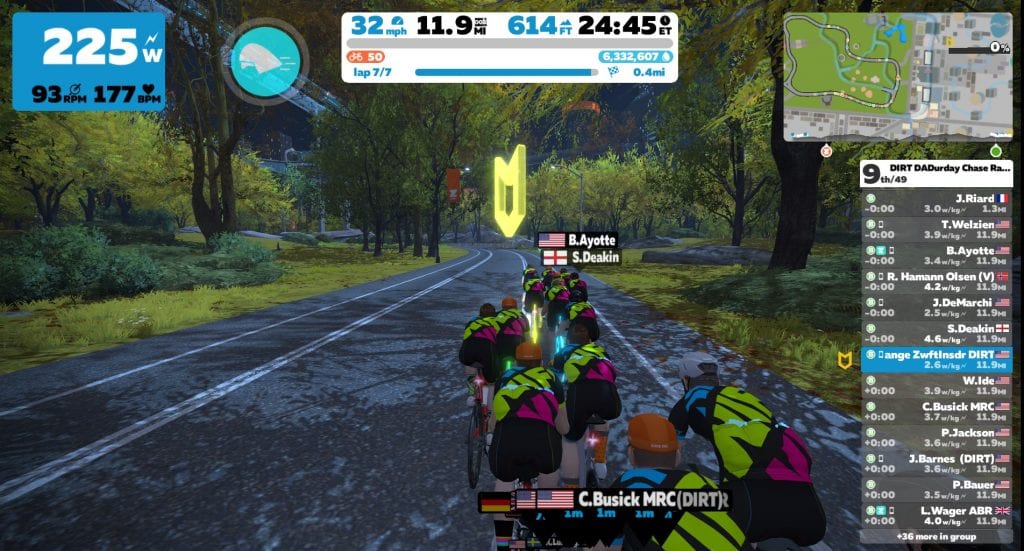
The Case of the Missing A’s
As we entered the final lap, we passed what I thought was the leading C group. Then we passed what I thought was the lead D group.
Behind us I could see some A’s chasing. Very close. Or was it just one A? Hard to tell, but just when I thought we’d get caught by the A riders, they seemed to slow down and hang with the group behind my hard-charging B squad.
That was odd. Typically at this point in the race, the B’s are tired and the A’s have the stamina to blow through the pack and keep charging.
To this day, I’m still not sure what happened to those A riders. But I have a theory: I think Ben was pulling a small group of A’s, but he didn’t want to contend for the overall win. That’s a non-uncommon pro move in low-level Zwift and outdoor races, because a pro rider basically has two options in these situations:
- Fight for the win and possibly lose. Losing looks really bad if you’re the only pro on course. And sometimes, winning against a bunch of amateurs looks worse!
- Sit up at the end and let others fight it out. You get a good workout, and everyone knows you weren’t really trying to win, so your reputation doesn’t suffer in any way.
It’s also possible that he and/or some of the other A’s, unlike myself, realized the A’s didn’t stand a chance of being in the mix for the overall podium, so they all sat up.
The Finish
Whatever the reason, in the end it was my pack of 18 B’s (we started with 49) going all-out up the final kicker and into the downhill sprint finish. Every man for himself!
The powerup gods had smiled upon me with an aero helmet, so I popped that and gave it all I had. Which wasn’t much. But it was enough for 3rd place in the B’s:
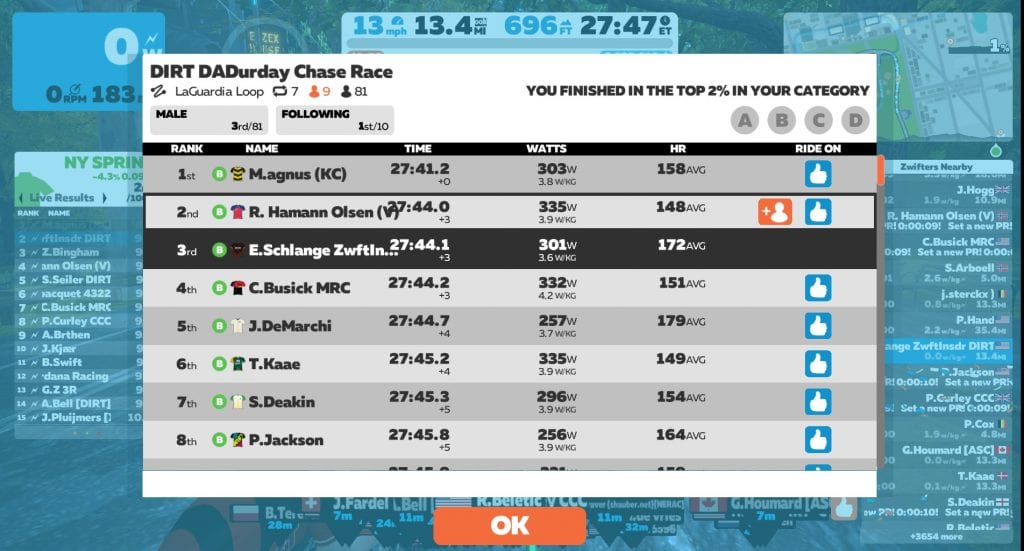
The Hammer Drops
I headed over to ZwiftPower to check results, and that’s where I got the bad news: we never caught the front of the race.
Oops. Who gave this guy the leader beacon, anyway?
Yes, according to ZwiftPower, 12 D’s and 7 C’s had finished ahead of our B group. Well ahead, in fact: David Ramsey, a D who took the overall first place, finished 3 minutes and 37 seconds ahead!
Sandbagging Handicaps
Without attacking anyone personally, I want to discuss how this race perfectly spotlights the way sandbaggers (riders who race in a lower category than they should) have made a shambles of chase race results on Zwift.
For chase races to work, categories must be separated by time gaps which allow the categories to come together near the very end of the race, so everyone is sprinting together for the win. It doesn’t always work out perfectly (setting those gaps can be a challenge!), but experienced race organizers have it figured out pretty well at this point.
In our case, the B’s started 8 minutes behind the D group and 3 minutes behind the C group. In the end, ZwiftPower shows the front D’s finishing 3:37 ahead of us, while the front C’s finished 1:17 ahead.
But ZwiftPower doesn’t tell the whole story.
A look at the results in Zwift Companion shows that the C and D groups were stuffed full of sandbaggers. Here are screenshots of the top finishers in each category, with names crossed out if the rider was DQ’d or not signed up for ZwiftPower (remember, I said no personal attacks).
(The red X denotes obvious sandbaggers–those who exceeded category limits by 0.3w/kg or more.)
Crazy, right? 5 of the top 10 C’s were sandbagging. And 8 of the top 10 D’s!
What this means is, the C and D groups were pulled along at much higher speeds than they should have been, because riders in those groups were putting out efforts above C and D levels. This basically made it impossible for the B and A riders to catch the front of the race.
The solution to this problem is for Zwift to figure out a workable system that places riders in the correct category when signing up. I’ve written more about this in my “Enforcing Race Categories” series.
Obviously this doesn’t diminish the results of the legit C’s and D’s who took the win. I say chapeau to them! Again, I just think it’s worth highlighting how sandbagging affects chase races.
Interestingly, the B’s had no obvious sandbaggers in the group. And the A’s? Well… look who took the win:
Nice work, Mr. Swift! In the end, Ben completed the race 26 seconds faster than me. But since the A’s started 1 minute after the B’s, we finished ahead of him.
So that’s a win, right? 😉
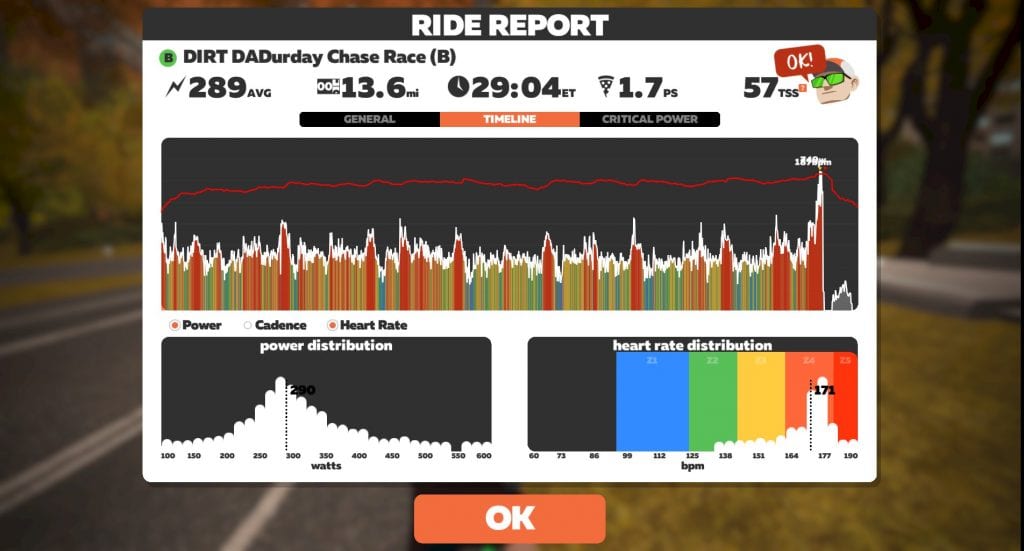
Takeaways
My main takeaway for this race is simply that I need to use ZwiftPower’s live feed in future chase races, especially those on smaller loops, and especially DADurday races where I’ve got the leader beacon.
This will let me easily see where the other categories are in relation to mine, so I can decide if I want to go faster, or conserve energy for the finish.
Your Thoughts
Ever beat a pro in a Zwift race? Enjoyed a solid DADurday, ZHR, or Lamb Chop chase effort? Share your thoughts below!
